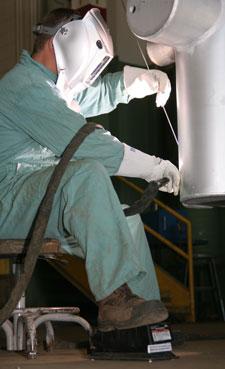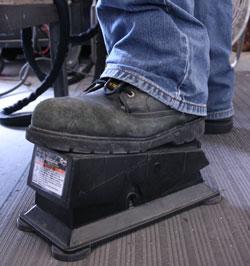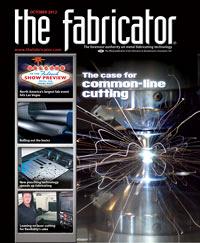Editor-in-Chief
- FMA
- The Fabricator
- FABTECH
- Canadian Metalworking
Categories
- Additive Manufacturing
- Aluminum Welding
- Arc Welding
- Assembly and Joining
- Automation and Robotics
- Bending and Forming
- Consumables
- Cutting and Weld Prep
- Electric Vehicles
- En Español
- Finishing
- Hydroforming
- Laser Cutting
- Laser Welding
- Machining
- Manufacturing Software
- Materials Handling
- Metals/Materials
- Oxyfuel Cutting
- Plasma Cutting
- Power Tools
- Punching and Other Holemaking
- Roll Forming
- Safety
- Sawing
- Shearing
- Shop Management
- Testing and Measuring
- Tube and Pipe Fabrication
- Tube and Pipe Production
- Waterjet Cutting
Industry Directory
Webcasts
Podcasts
FAB 40
Advertise
Subscribe
Account Login
Search
Cutting the GTAW remote control cord
Fabricator finds freedom, increased productivity with remote foot control
- By Dan Davis
- October 23, 2012
- Article
- Arc Welding

Figure 1: Testing of wireless GTAW foot pedals revealed that even welders who worked exclusively in a small area liked the idea of having no cord on the floor. A cord often was hard to pull along as the welder changed positions. The welders also didn’t have to worry about fixtures that are rolled around the shop possibly fraying foot pedal cords.
Gas tungsten arc welding (GTAW) is difficult enough without having to move the foot pedal control every time the welder needs to change positions. It builds up frustration just when the welder needs to keep his cool as he strikes his electrode to the metal to begin another pass.
That doesn't have to be the case, however. Wireless technologies have advanced to the point where cordless remote welding controls are being adopted at an increasing rate, and cordless GTAW foot pedals are just one example. And it's just not the welders involved in fieldwork—which may require hundreds of feet of extensions in some cases—who want to cut the cord; welders in shops want freedom as well.
Chart Industries' Energy & Chemicals Group in La Crosse, Wis., learned that firsthand. It also discovered that it is sometimes easy to overlook the downtime that occurs with the everyday challenges of working with corded foot pedals.
Proof in the Productivity
Approximately 120 welders work on brazed aluminum heat exchangers for air separation and hydrocarbon plants at the Wisconsin facility. Weldments can range in size from 6 in. high by 6 in. wide by 12 in. long to 114 ft. high by 52 ft. wide by 28 ft. long, with the latter weighing as much as 60,000 lbs. As a result, it's not uncommon to see the welders moving frequently as they tackle a large welding job. Of course, that also means they inevitably pull and tug on a foot pedal cord as they attempt to move around. Some cords don't survive the tug of war or the harsh welding environment in general.
"For our processes, a lot of [the cords] were getting damaged from either molten aluminum or the cords getting caught on different things, such as lifts or something like that. Then the cord would get ripped out," said Kevin Bigley, a Chart weld engineer technician.
Once the cord to the foot pedal control was damaged, the welder had to hunt around to find a spare. The damaged units were taken to the facility's on-site electricians in the hope that they could put new cords on the foot controls to repair them as best as they could. (In some instances, the cost for a new cord for a foot pedal was half the cost of a new foot control.) Pedals that were too damaged had to be replaced, so new orders for spare corded foot pedals were placed.
"[The electricians] were spending quite a few hours a week just repairing them. We basically had one electrician dedicated to that. We couldn't do that anymore," Bigley said.
In early 2010 Miller Electric formally launched its first wireless GTAW foot control. The Chart facility, which is near Miller's Appleton, Wis., corporate headquarters, had worked with Miller in the past, acting as a beta site for its Dynasty® 700 GTAW power sources. It had the good fortune of acting in the same testing role for the new GTAW foot pedals (see Figure 1).
"We were capable of taking it and wandering around the plant and doing different things with it as we wanted to or needed to," Bigley said. "It proved itself, I guess, to the welders themselves as they used them."
Even though the equipment is designed to work at a maximum range of 90 ft., Bigley said that they have stretched it beyond that equipment spec. The company has also found that the device works even when obstacles are between the power source and the cordless foot control. Chart's welders have used the foot pedal inside the facility's pneumatic test facility, while the power source sat outside of the room's 2-ft.-thick walls.

Figure 2: When a welder walks into the cord of a GTAW foot pedal control, the cord has a tendency to wrap around the foot, causing a greater chance of tripping. When a welder walks into a wireless foot pedal, he or she may still trip, but there is no cord to grab at the foot.
Bigley added that any skepticism the welders may have had about a wireless foot pedal control evaporated almost immediately after using the new pedals. The welders weren't missing a beat laying their beads, and they weren't making so many trips to visit the electricians.
Wireless Advances Make It Work
Brent Williams, a Miller Electric marketing manager, said the main goal of bringing a wireless remote control to market was to produce a foot pedal that was as responsive and reliable as a corded model. That was made possible with advancements in wireless radio technology and the subsequent fall in prices for those types of units. It finally made sense to give TIG welders what they had been asking for for years.
"So [welders] were really looking forward to the concept, but they said we have to try it first and we have to make sure it performs the same way [as the corded controls]," Williams said.
Welders were concerned about potential interference from other wireless foot pedals and high-frequency signals being emitted from other devices, such as mobile phones. Williams said the same technology—Miller calls it multiple frequency sharing—that allows people to have separate mobile phone conversations while they stand next to each other and not worry about interference from the other's phone keeps the welding control interference-free. Each unit has a "unique addressing system," like its own mobile phone number, according to Williams, which keeps the two-way communication shielded from outside influences.
"This type of technology has been used in applications such as overhead cranes where they will have a remote and basically no cord needed to move that crane. We have seen it used in boatyards where they have very big structures where they need wireless technology to move around the boats," Williams added. "We started feeling that if you could use [the wireless controls] in those applications, that we should be able to adopt the technology for welding."
Extensive testing at the Miller Electric facilities proved that other high-frequency signals wouldn't interfere with the operation of the power source or remote foot control. That testing was necessary, according to Williams, because any sort of abrupt power source interruption during GTAW can possibly damage the machine or cause the weld to fail an inspection test because of the unscheduled stoppage during a critical weld.
Free at Last
In addition to improving productivity and protecting the power source and weld integrity, cordless foot controls arguably are keeping Chart welders safe (see Figure 2). One less tripping hazard is always a good thing.
"The welders love them. It's the freedom. There are no extra cords laying around," Bigley said. "We have enough cords laying around between air lines and sometimes extension cords, so one less cord is always nice."
Currently Chart welders use about a dozen of the wireless foot pedals. Bigley said that the more welders can prove that the remote GTAW control is helping eliminate downtime, the more they will be able to justify purchasing more of the units, which are more expensive than their corded counterparts.
Williams said as more welders adopt the wireless control technology the price should come down accordingly, and welders will find more of their distributors keeping the product in stock. Now it's just a matter of getting the word out that it's possible for TIG welders to cut the cord if they want to.
Chart Industries, Energy & Chemicals Group, 2191 Ward Ave., La Crosse, WI 54601, 608-787-3333, www.chart-ec.com
About the Author

Dan Davis
2135 Point Blvd.
Elgin, IL 60123
815-227-8281
Dan Davis is editor-in-chief of The Fabricator, the industry's most widely circulated metal fabricating magazine, and its sister publications, The Tube & Pipe Journal and The Welder. He has been with the publications since April 2002.
Related Companies
subscribe now

The Fabricator is North America's leading magazine for the metal forming and fabricating industry. The magazine delivers the news, technical articles, and case histories that enable fabricators to do their jobs more efficiently. The Fabricator has served the industry since 1970.
start your free subscription- Stay connected from anywhere

Easily access valuable industry resources now with full access to the digital edition of The Fabricator.

Easily access valuable industry resources now with full access to the digital edition of The Welder.

Easily access valuable industry resources now with full access to the digital edition of The Tube and Pipe Journal.
- Podcasting
- Podcast:
- The Fabricator Podcast
- Published:
- 04/16/2024
- Running Time:
- 63:29
In this episode of The Fabricator Podcast, Caleb Chamberlain, co-founder and CEO of OSH Cut, discusses his company’s...
- Industry Events
16th Annual Safety Conference
- April 30 - May 1, 2024
- Elgin,
Pipe and Tube Conference
- May 21 - 22, 2024
- Omaha, NE
World-Class Roll Forming Workshop
- June 5 - 6, 2024
- Louisville, KY
Advanced Laser Application Workshop
- June 25 - 27, 2024
- Novi, MI































